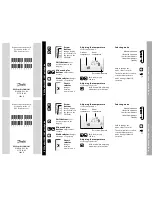
HT46R46/C46/R47/C47/R48A/C48A/R49
Rev. 1.41
36
December 30, 2008
All of these interrupts have the capability of waking up
the processor when in the Power Down Mode.
Only the Program Counter is pushed onto the stack. If
the contents of the register or status register are altered
by the interrupt service program, which may corrupt the
desired control sequence, then the contents should be
saved in advance.
Reset and Initialisation
A reset function is a fundamental part of any
microcontroller ensuring that the device can be set to
some predetermined condition irrespective of outside
parameters. The most important reset condition is after
power is first applied to the microcontroller. In this case,
internal circuitry will ensure that the microcontroller, af-
ter a short delay, will be in a well defined state and ready
to execute the first program instruction. After this
power-on reset, certain important internal registers will
be set to defined states before the program com-
mences. One of these registers is the Program Counter,
which will be reset to zero forcing the microcontroller to
begin program execution from the lowest Program
Memory address.
In addition to the power-on reset, situations may arise
where it is necessary to forcefully apply a reset condition
when the microcontroller is running. One example of this
is where after power has been applied and the
microcontroller is already running, the RES line is force-
fully pulled low. In such a case, known as a normal oper-
ation reset, some of the microcontroller registers remain
unchanged allowing the microcontroller to proceed with
normal operation after the reset line is allowed to return
high. Another type of reset is when the Watchdog Timer
overflows and resets the microcontroller. All types of re-
set operations result in different register conditions be-
ing setup.
Another reset exists in the form of a Low Voltage Reset,
LVR, where a full reset, similar to the RES reset is imple-
mented in situations where the power supply voltage
falls below a certain threshold.
Reset Functions
There are five ways in which a microcontroller reset can
occur, through events occurring both internally and ex-
ternally:
·
Power-on Reset
The most fundamental and unavoidable reset is the
one that occurs after power is first applied to the
microcontroller. As well as ensuring that the Program
Memory begins execution from the first memory ad-
dress, a power-on reset also ensures that certain
other registers are preset to known conditions. All the
I/O port and port control registers will power up in a
high condition ensuring that all pins will be first set to
inputs.
Although the microcontroller has an internal RC reset
function, if the VDD power supply rise time is not fast
enough or does not stabilise quickly at power-on, the
internal reset function may be incapable of providing
proper reset operation. For this reason it is recom-
mended that an external RC network is connected to
the RES pin, whose additional time delay will ensure
that the RES pin remains low for an extended period
to allow the power supply to stabilise. During this time
delay, normal operation of the microcontroller will be
inhibited. After the RES line reaches a certain voltage
value, the reset delay time t
RSTD
is invoked to provide
an extra delay time after which the microcontroller will
begin normal operation. The abbreviation SST in the
figures stands for System Start-up Timer.
For most applications a resistor connected between
VDD and the RES pin and a capacitor connected be-
tween VSS and the RES pin will provide a suitable ex-
ternal reset circuit. Any wiring connected to the RES
pin should be kept as short as possible to minimise
any stray noise interference.
For applications that operate within an environment
where more noise is present the Enhanced Reset Cir-
cuit shown is recommended.
More information regarding external reset circuits is
located in Application Note HA0075E on the Holtek
website.
R E S
V D D
S S T T i m e - o u t
I n t e r n a l R e s e t
0 . 9 V
D D
t
R S T D
Power-On Reset Timing Chart
R E S
0 . 1
m
F
1 0 0 k
W
V D D
V S S
0 . 0 1
m
F
1 0 k
W
Enhanced Reset Circuit
R E S
V D D
V S S
0 . 1
m
F
1 0 0 k
W
Basic Reset Circuit
















































